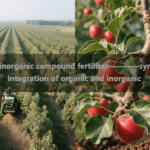Let more growers get greater benefits
Organic-inorganic compound fertilizer——synergistic integration of organic and inorganic
- Industry News
- August 29, 2025
- 2:15 pm

As agriculture strives for high yields, high quality, and sustainable development, fertilizer selection is a core concern for growers. While traditional single organic fertilizers can improve soil and crop quality, they suffer from slow nutrient release and a long lead time. While inorganic fertilizers can quickly replenish nitrogen, phosphorus, potassium, and other elements, long-term use can easily lead to soil compaction, fertility loss, and even environmental problems. To overcome this “single fertilization” dilemma, organic-inorganic compound fertilizers have emerged. These fertilizers scientifically combine the long-term improvement benefits of organic fertilizers with the quick-acting replenishment properties of inorganic fertilizers. They address the challenge of sustainable soil fertility while meeting the nutrient needs of crops at different growth stages. They serve as a bridge between traditional farming wisdom and modern fertilization techniques, providing a key fertilizer solution for green agricultural development.
List of Contents
Organic-inorganic compound fertilizers —— macronutrients (N, P, K)
The large amount of elements in organic-inorganic compound fertilizers meet the different growth needs of crops through the “rapid fertilizer supply of inorganic forms + synergistic efficiency of organic ingredients” method. The specific functions are as follows:
- Nitrogen (N):The structural protein chlorophyll determines the growth potential, promotes growth and strong photosynthesis affects the reproductive period.
- Phosphorus (P):It helps energy metabolism, promotes rooting and fruiting, and strengthens crops’ resistance to cold, drought and stress.
- Potassium (K):Adjust osmotic pressure to resist stress, promote the transfer of photosynthetic products and improve quality.
Medium nutrient fertilizer
Although the demand for secondary elements is moderate, they are involved in core physiological processes such as the construction of crop cell structure and the regulation of enzyme activity. Their deficiency will directly lead to “physiological diseases”. Their specific functions are as follows:
- Calcium (Ca): Strengthens cell walls, prevents cracking and reduces the absorption of heavy metals.
- Magnesium (Mg): The core of chlorophyll promotes photosynthesis, regulates enzyme activity and helps carbohydrate synthesis and transportation.
- Sulfur (S): A protein-building vitamin that enhances flavor, promotes nitrogen absorption and increases resistance to stress.
Chelated micronutrient fertilizers
Organic-inorganic compound fertilizers usually contain trace elements that match crop needs (usually added in amounts of 0.5%-5%). Iron, zinc, boron, manganese, and molybdenum are the most critical and most easily deficient in agricultural production. Their specific functions are as follows:
| Trace Element | Function | Adapted Crops | Typical Deficiency Symptoms |
| Iron (Fe) | Promotes chlorophyll/photosynthesis/nitrogen metabolism, reduces harmful substances | Citrus, strawberry, grape, etc. (acid-loving crops prone to deficiency) | New leaves yellow with green veins (different from N deficiency), prone to deficiency in alkaline soil |
| Zinc (Zn) | Aids auxin synthesis, promotes carbon-nitrogen metabolism, enhances stress resistance | Corn, rice, apple, tomato, etc. | Small leaf disease, dwarfing, fruit malformation, excessive P inhibits Zn absorption |
| Boron (B) | Promotes pollen development/fruiting, aids cell wall/carbohydrate transport | Rape, cotton, grape, pepper, etc. | Sterile flowers, fruit cracking, terminal bud necrosis, cruciferous crops sensitive |
| Manganese (Mn) | Aids photosynthetic light reaction, activates enzymes, enhances stress resistance | Wheat, rice, beet, potato, etc. | Brown-gray spots on old leaves (different from Fe deficiency), prone to deficiency in acidic soil |
| Molybdenum (Mo) | Essential for legume nitrogen fixation, promotes N conversion, aids vitamin C synthesis | Soybean, peanut, rape, spinach, etc. | Small root nodules in legumes, leaf curling, prone to deficiency in acidic soil |
Three Advantages of Trace Elements in Organic-Inorganic Compound Fertilizer
-
Long-Term Release to Avoid “Short-Term Deficiency”
Organic matter (humic acid, amino acid) forms chelates with trace elements, slowing loss or fixation. It releases slowly throughout the growth period, suitable for crops with long fertilizer demand such as fruit trees and cotton, avoiding “no deficiency in seedling stage but deficiency in later stage”. -
Synergistic Absorption to Improve Utilization Rate
Organic matter activates ineffective trace elements in soil and promotes root development. Inorganic N, P, K form a synergistic effect with trace elements (e.g., N promotes Zn absorption), avoiding “absorption barriers” from single supplementation. -
Convenient Application to Reduce Labor Costs
Single trace element supplementation requires multiple sprays (e.g., boron spraying before flowering). It can be applied once with base fertilizer/topdressing without additional labor, suitable for farmers with field crops and orchards lacking labor.
Conclusion
Choosing organic-inorganic compound fertilizers offers significant advantages for simultaneously maintaining soil health and efficiently fertilizing crops. First, they offer comprehensive and balanced nutrition. Organic components (such as humic acid and organic matter) improve soil structure and enhance water and fertilizer retention, while inorganic components (nitrogen, phosphorus, potassium, etc.) quickly replenish key nutrients for crop growth, preventing soil compaction or nutrient imbalances caused by single fertilization. Second, they offer long-lasting and stable fertilizer effects. Organic nutrients are slowly released to meet the long-term needs of crops, while inorganic nutrients are immediately available to alleviate nutrient deficiencies during the seedling stage, achieving a combination of “fast-acting and long-lasting” effects. Third, they enhance crop quality and stress resistance. Organic matter promotes the activity of beneficial soil microorganisms, strengthens crop resistance to pests and diseases, and resists lodging, while reducing the residual effects of excessive chemical fertilizer use on agricultural products. This makes them an ideal fertilizer for balancing agricultural production increases with ecological sustainability.
If you want to know other questions about Tomato fertilizer or NPK fertilizers , please contact us and we will provide professional answers.
- Article
What will you get when touch?
✔ Quick & helpful reply within 6 hours.
✔ Tailored solutions for your project.
✔ One-stop product, tech, market
TRENDING
Want to find a China fertilizer manufacturer?
Risso will be your best choice; send us your request for your fertilizer details requirement.
TAIAN RISSO CHEMICAL FERTILIZER CO.,LTD
- Address: High-tech Development Zone, Taian City, Shandong Province
© Copyright 2017 RISSO CHEMICAL. All Rights Reserved.







